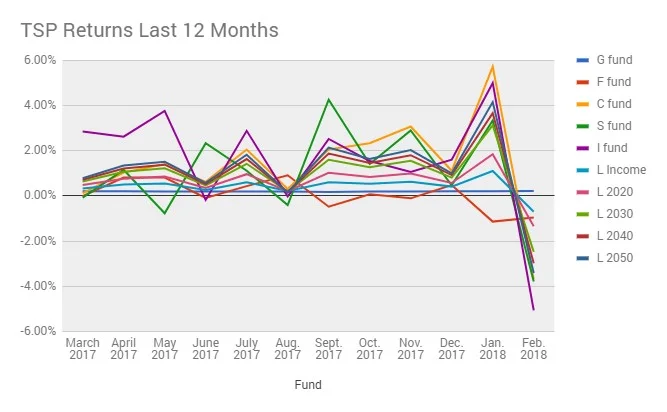(for the week of February 24th – March 2nd)
You’re too busy during the week to keep up on all the news around your employee benefits and pay. My weekly summary of the most interesting and relevant news stories could help you and includes my comments and insights.
By the way, if you’ve read something about your employee benefits that you think is important or interesting, share it. And, let me know about news sources that you follow. Have a great weekend.
George Ray
Federal Benefits Online
In this week’s Federal benefits news, Ted wants your name on his ‘non-essential’ list, the TSP has been getting a lot of calls lately, recent TSP fund performance provides some valuable lessons, and I answer the question ‘What Do Federal Executive Boards Do?”. Let’s get started.
Congressman Wants List of Employees Deemed 'Non-Essential' During Shutdown
From govexec.com
I was not surprised when I read this article. It was only a matter of time. Ted Budd, a Republican lawmaker from North Carolina, is kicking a** and taking names. He’s proposed something called The Essential Act (H.R. 5091) which would require the Office of Management and Budget (OMB) to maintain a database of Federal employees (including their job descriptions and salaries) who are furloughed during a government shutdown. You know where this is going, don’t you?
If roughly 800,000 Feds were sent home without pay during the most recent shutdown, they must not be ‘essential’ to the operation of the government. If we just had the list, we could start to address ‘the bloated bureaucracy’ according to Ted.
Well firstly, Ted, you need to know that ‘essential’ and ‘non-essential’ are not terms that the Federal government uses. We discussed this back in January in this issue with an excellent article from Jeff Neal at chiefhro.com titled “Shutdown: It Ain’t Over When Its’ Over”. Employees are either exempt employees (paid through appropriations that are not part of the budget to be passed by Congress), excepted employees (who are engaged in activities necessary for safety like Border Patrol and air traffic controllers), and then there are furloughed employees (whose work, although necessary to run the government and provide services, are sent home without pay because their work doesn’t have the urgency of the excepted employees group).
Let’s hope that the Feds living in North Carolina tell Ted that he’s the one who is non-essential next time they vote. The rest of you may just want to tell him what he can do with his list.
You’re Not Imagining It. Wait Times at TSP Call Centers are at Least 3 Times Longer Than Usual
From federalnewsradio.com
The goal is to answer 90% of the calls within 20 seconds, but that was tougher to do in January. Calls to the TSP’s call centers usually go up at the beginning of the year since there are lots of tax-related questions and questions from new retirees about their distributions.
But this year, the TSP is also dealing with lots of new participants. The Federal Retirement Thrift Investment Board (FRTIB) opened the blended retirement system to military members on January 1st and so far, over 119,000 participants have signed up. But strangely enough, they’re not the ones with all the questions.
The TSP folks said most of the questions clogging up the phone lines are about new capabilities they’ve recently put in place, like requiring participants to set a stronger password. Some IT modernization updates are also slowing down their customer service reps as they’re getting used to the changes. Some bad weather (it’s been a rough winter in the East) has also caused staffing issues. To fix things, the TSP folks have been adding more staff and extending call center hours. It’s good to hear that they’re staying on top of things. Now, if they could only do something about this . . .
Most TSP Funds Plunge Sharply in February
From Federalnewsradio.com
I don’t usually include photos, but they say a picture is worth a thousand words. This picture must be worth at least double that. Although I’m not going to write 2,000 words, I do have a few thoughts.
After the euphoria most investors were feeling in December and January, corrections like this are an important reminder that markets go both up and down. It also reinforces that you should have an investment strategy that is appropriate for your risk tolerance and time horizon. Hopefully, you weren’t greedily loading up on stocks over the last two months, and if you did, you’re not fearfully letting your emotions get the best of you by bailing out now. My understanding is that some of the current TSP millionaires (there may not be quite as many now) got that way by staying the course with their strategies after the market meltdown in 2008. Just saying.
By the way, someone will probably mention this. If you look really hard at the photo, you will find a blue line positioned slightly above 0.00% that doesn’t have a bend in it. In the photo, it’s the only line that’s still above 0.00% (and all the others) on the right. That’s the G Fund. It confirms why as you get closer to retirement most advisers recommend that your strategy shifts to include more of this fund, so you know where your retirement savings are after the markets close.
What Do Federal Executive Boards Do?
From federalbenefitsonline.com
In my weekly news review, I found a recently published annual report for the Federal Executive Board National Network. There’s a common misconception that most of the Federal workforce is located in Washington, DC, but you probably know that most Federal employees (about 79%) are located outside the nation’s capital. They’re the park rangers in our national parks, the law enforcement officers who keep our borders safe, the air traffic controllers in airports around the country, and the postal employees in every town, large and small, throughout the US. But just because you may be far away from Washington DC geographically, where most all agencies have their headquarters, you shouldn’t feel isolated.
Back in 1961, President Kennedy established the formation of the Federal Executive Boards (FEBs) through a Presidential directive to provide interagency coordination and communications among local agency offices, outside of Washington DC. There are currently 28 Boards, overseen by the Office of Personnel Management (OPM), which serve about 38% of the Federal workforce. They’re located throughout the US and are typically comprised of the highest ranking local Federal officials. Officers on the Boards are elected annually. Most Boards have an Executive Director and an Assistant, who may be ‘on-loan’ from their agency(s) and are responsible for day-to-day operations. So, what do they do? Read my latest blog post to learn what they really do. Then, let me know if you agree and share your insights.
See you next week. Thanks.
Get the help you need to understand and wisely use your benefits. Do it when you’re ready and at your own pace. Let me be your guide to “Understanding Your Federal Benefits” and become the boss of your benefits with my comprehensive e-learning course. There’s a free trial that gives you the course introduction and first module at no charge. Give it a look. You’ll like what you see.
Read past issues of the newsletter and other blog posts at What’s New?
You can get the newsletter sent directly to your inbox if you subscribe here.
You can also follow Federal Benefits Online on our Facebook fan page.
Issue 9-18
Published by Federal Benefits Online.
Copyright © 2018
Author: George Ray

